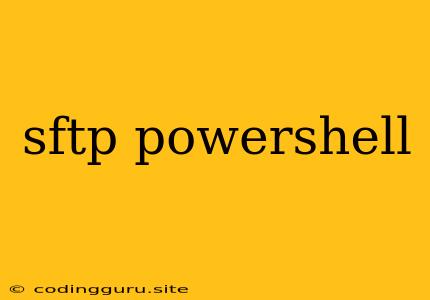Mastering SFTP with PowerShell: A Comprehensive Guide
SFTP (Secure File Transfer Protocol) is a vital tool for securely transferring files between computers. PowerShell, a powerful scripting language for Windows, provides a robust and efficient way to interact with SFTP servers. This comprehensive guide will delve into the intricacies of using PowerShell for SFTP operations, empowering you with the knowledge to streamline your file transfer processes.
Why Choose PowerShell for SFTP?
PowerShell offers a multitude of advantages when managing SFTP tasks, surpassing traditional methods:
- Automation: PowerShell allows you to script complex SFTP workflows, automating file transfers, directory management, and other tasks. This frees you from repetitive manual operations, boosting productivity.
- Flexibility: PowerShell scripts are highly adaptable, allowing you to tailor your SFTP interactions to meet specific requirements, including custom file filtering, error handling, and logging.
- Integration: PowerShell integrates seamlessly with other Windows components and tools, allowing you to incorporate SFTP operations into broader automation pipelines.
- Security: PowerShell scripts can utilize secure authentication methods, such as SSH keys, ensuring the safety of your data during transfer.
Getting Started with PowerShell SFTP
Before diving into specific commands, you'll need to install the necessary PowerShell module for SFTP operations:
-
Install the SFTP Module: Open PowerShell as administrator and execute the following command:
Install-Module -Name Renci.SshNetThis command installs the Renci.SshNet module, a widely used library providing SFTP functionality.
-
Verify Installation: Ensure the module is installed by checking the available modules:
Get-Module -ListAvailable -Name Renci.SshNetYou should see the module listed in the output.
Connecting to an SFTP Server
With the module installed, you can establish a connection to your SFTP server using the following script:
# Connect to the SFTP server
$sftp = New-Object Renci.SshNet.SftpClient('your_server_hostname', 'your_username', 'your_password')
$sftp.Connect()
# Check if the connection was successful
if ($sftp.IsConnected) {
Write-Host "Connection to SFTP server established successfully!"
} else {
Write-Host "Error connecting to SFTP server."
}
- Replace Placeholders: Replace
your_server_hostname,your_username, andyour_passwordwith your actual server information. - Secure Authentication: For enhanced security, consider using SSH keys instead of passwords. The
SshClientobject offers methods to authenticate using private keys.
Performing SFTP Operations
Now that you have a connection, you can perform various SFTP operations. Let's explore some common examples:
1. Downloading Files:
# Download a file from the server
$sftp.DownloadFile('remote_file.txt', 'C:\local_path\remote_file.txt')
# Download multiple files with wildcard pattern
$sftp.DownloadFiles('*.log', 'C:\local_path')
- Remote Path: Specify the file or directory path on the SFTP server (e.g.,
/home/user/files/). - Local Path: Provide the local path where the file should be downloaded.
2. Uploading Files:
# Upload a single file
$sftp.UploadFile('C:\local_path\local_file.txt', 'remote_file.txt')
# Upload multiple files recursively
$sftp.UploadDirectory('C:\local_path', '/home/user/uploads', $true)
- Local Path: Specify the path to the file or directory on your local machine.
- Remote Path: Provide the destination path on the SFTP server.
3. Listing Directory Contents:
# List files and directories
$sftp.ListDirectory('/home/user/data')
# Filter files by extension
$sftp.ListDirectory('/home/user/data', { $_.Name -match '.txt' })
- Directory Path: Provide the SFTP server directory you want to list.
- Filter (Optional): Use a filter to retrieve specific files or directories.
4. Creating and Deleting Directories:
# Create a new directory
$sftp.CreateDirectory('/home/user/new_folder')
# Delete a directory
$sftp.DeleteDirectory('/home/user/old_folder')
5. Advanced SFTP Operations:
PowerShell provides additional functionality for advanced SFTP tasks, including:
- File Manipulation: Renaming, moving, copying, and deleting files.
- Permissions: Setting and modifying file and directory permissions.
- Error Handling: Implementing error handling to gracefully manage unexpected issues.
- Logging: Recording SFTP operations for audit purposes.
Example SFTP Script:
# Connect to the SFTP server
$sftp = New-Object Renci.SshNet.SftpClient('your_server_hostname', 'your_username', 'your_password')
$sftp.Connect()
# Download all CSV files from a directory
$sftp.DownloadFiles('*.csv', 'C:\local_path')
# Upload a log file to the server
$sftp.UploadFile('C:\local_path\log.txt', '/home/user/logs/log.txt')
# Disconnect from the SFTP server
$sftp.Disconnect()
Key Considerations for PowerShell SFTP:
- Security: Prioritize secure authentication methods, such as SSH keys, to protect your data.
- Error Handling: Implement robust error handling mechanisms to handle unexpected situations during file transfers.
- Performance: Optimize your scripts for efficient file transfer operations by considering factors like file size and network bandwidth.
Conclusion:
By leveraging the power of PowerShell, you can automate and simplify your SFTP workflows, enhancing efficiency and security. This guide has provided a comprehensive overview of the fundamentals of SFTP with PowerShell. Remember to explore the SshNet module documentation for advanced features and customization options to tailor your SFTP operations to specific needs.
